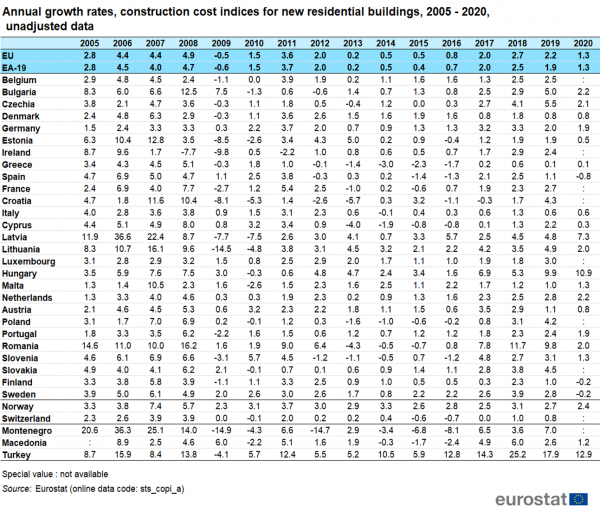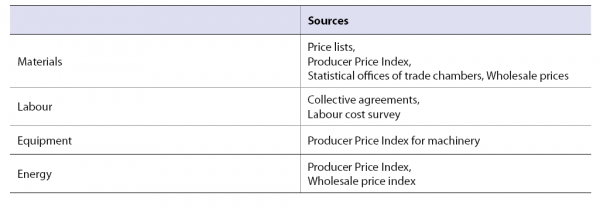How To Use Enr Construction Cost Index
Construction costs - development since 2005
Betwixt 2005 and mid-2008 construction costs (for residential buildings) increased relatively steadily in the European union (Figure 1). Later on peaking in the 3rd quarter of 2008 the index began to fall and reached its everyman level most 1 year later. In total, however, the decline was not especially pronounced. In 2010, the index started to increment once again. Less than 1 yr later information technology regained the level it had displayed before the financial and economic crisis. Until 2012, the indices increased further and and then stagnated for a relatively long flow betwixt 2012 and 2016, when some other continuous increment ready in. The construction cost and prices indices were not strongly affected by the Covid-19 crunch in the starting time and second quarters of 2020. After, however, a dynamic growth fix in that was particularly driven by the costs for input materials.
The development of the construction toll alphabetize was mainly influenced by the material cost component (which accounts for around two thirds of the total costs), while the labour cost component continued to grow even during the crisis - although at a slower pace than earlier.
Tabular array 1 provides the almanac growth rates for the European union, the euro area, and the Member States for the catamenia betwixt 2005 and 2020. With few exceptions, the EU countries display a evolution that is broadly similar to the ane for the Eu amass. Some differences can be found in the timing and the size of the decrease in the cost index. The construction cost index for residential buildings started to fall first in Republic of ireland (in 2008), in the other countries this development occurred several months later. The reductions in the price index were relatively strong in Ireland and in the Baltic States. In a number of countries the rates of change in 2008 and 2009 remained positive although generally lower than in the beginning one-half of the period under observation. In 2011, simply Ireland experienced a decline in the construction price index. During the years 2011 to 2016, construction costs annually increased past around 1.v %, during the last 3 years the growth accelerated to around 2.3 % per yr. The almanac data for 2020 practise not show a stiff consequence of the Covid-nineteen pandemic. While during the starting time quarters of the year the costs might have stagnated or declined, the development during the second half of the year compensated this.

Tabular array 1: Annual growth rates, construction toll indices for new residential buildings, unadjusted data, Source: Eurostat (sts_copigr_a)
Data sources
The Regulation (European union) No 2019/2152 of 27 November 2019 (European Concern Statistics Regulation) calls for quarterly indices on construction costs for new residential buildings, excluding residences for communities. Data are revised when additional information from national statistical regime becomes available. In general, no special surveys are undertaken in order to summate the construction cost index since it is possible to use other indices that are already available from different sources.
Data collected past Member States are transmitted to Eurostat as an index. The weighting for aggregating this index betwixt Fellow member States is by and large turnover in building construction and is derived from information obtained from structural business statistics or other statistics. The base of operations year is usually changed every v years.
The CCI presents the total costs for new buildings. In addition, an index for cloth costs and an index for labour costs are bachelor. Material and labour costs represent the about important cost components for construction (Figure two).
Countries that do not have data on structure cost may employ structure producer prices (structure output prices) equally an approximation (see to a higher place).
Context

Figure 2: Construction cost index

Table ii: Sources for the construction cost index
The CCI provides important boosted aspects to the data provided by other construction data. The CCI measures developments from the points of views of the building contractors. It reflects the prices that they take to pay for the input factors in the structure process (see A in Effigy two). The price alphabetize therefore has to be distinguished from the producer price alphabetize for structure (also called output price index) which is seen from the indicate of view of the contractors' clients. The producer price index/output cost index (see B) shows the development of prices paid past the client to the contractor. These ii indices tin be distinguished from the "selling toll index" (item C) which measures changes in the prices paid by the terminal owner of the output to the customer. It includes the price of the land, builder's fees and client'south margins.
The CCI measures the relationship between the costs, at constant engineering and constant input mix, that are associated with the implementation of a fixed amount of construction work. This type of index is dissimilar from a producer price index, which measures movements in prices charged to clients of construction work. This is specially true when the price alphabetize is calculated from tender prices, which tin can vary from fourth dimension to time and identify to place depending on the land of competition and market atmospheric condition. Producer price indices include changes both in productivity and in the contractor's margins. This corresponds to item B in Figure 2.
The CCI is fabricated upwards of aggregated price indices for materials, labour costs and other types of costs. The aggregation takes into account the relative weights for the different toll components. The component costs index (fabric costs and labour costs) shows the toll developments of production factors used in the structure industry. Plant and equipment, transport, free energy and other costs are too components of the construction costs. Architect's fees are not part of the structure costs.
The material costs alphabetize is by and large calculated using materials prices and should be based on bodily prices rather than list prices. They should likewise exist based on a sample of products and suppliers. Prices are exclusive of VAT.
The labour toll index for the construction sector should comprehend wages and salaries and social security charges for all persons employed in the structure sector. Social security charges include statutory social contributions payable by the employer as well as collectively agreed, contractual and voluntary social contributions payable by the employer and too imputed social contributions (social benefits paid direct by the employer).
It is assumed that neither the construction method nor the building organization have undergone whatever alter, and consequently the calculations take no account of factors such as productivity improvements, more than efficient utilisation of materials, etc. which may influence cost trends. Changes in the profit margins, which also affect a producer toll index, have not been taken into business relationship either.
The structure producer price alphabetize (CPPI) measures the development of transaction prices for the quarterly construction output. According to the STS-Regulation National Statistical Institutes may produce the CPPI as an approximation for the structure toll index (see above).
The CPPI is an output index – it measures price changes from the makers of a product. The appropriate toll for calculating the PPI is the bones price that excludes VAT and similar deductible taxes which are directly linked to turnover. Toll indices are calculated as a weighted average of the relevant products.
How To Use Enr Construction Cost Index,
Source: https://ec.europa.eu/eurostat/statistics-explained/index.php/Construction_producer_price_and_construction_cost_indices_overview
Posted by: webbageres.blogspot.com


0 Response to "How To Use Enr Construction Cost Index"
Post a Comment